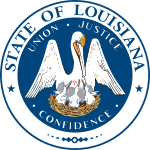| ||||||||||||||||||||||||||
| ||||||||||||||||||||||||||
 Parish Results
| ||||||||||||||||||||||||||
| ||||||||||||||||||||||||||
| Elections in Louisiana |
|---|
 |
|
|
The 1924 United States presidential election in Louisiana took place on November 4, 1924, as part of the 1924 United States presidential election, which was held throughout all contemporary forty-eight states. Voters chose ten representatives, or electors to the Electoral College, who voted for president and vice president.
Ever since the passage of a new constitution in 1898, Louisiana had been a one-party state dominated by the Democratic Party. The Republican Party became moribund due to the disenfranchisement of blacks and the complete absence of other support bases as Louisiana completely lacked upland or German refugee whites opposed to secession.[1] Despite this absolute single-party dominance, non-partisan tendencies remained strong among wealthy sugar planters in Acadiana and within the business elite of New Orleans.[2]
Following disfranchisement, the state's politics became dominated by the Choctaw Club of Louisiana, generally called the “Old Regulars”. This political machine was based in New Orleans and united with Black Belt cotton planters.[3] Opposition began to emerge with the Socialist Party in the lumbering parishes in the late 1900s, and more seriously with the Progressive movement, chiefly in the southern sugar-growing parishes, in the 1910s. Conflicts with President Wilson's Underwoood-Simmons Act[4] allowed a Progressive Party member in Whitmell P. Martin[a] to be elected to the Third Congressional District in 1914, and in 1920 the racially less hardline[5] Acadiana parishes turned to Republican candidate Warren G. Harding[6] over disagreements on foreign policy and the Nineteenth Amendment.[7] Continued opposition to the Choctaws would elect the reformer John M. Parker, originally part of Theodore Roosevelt's Bull Moose Party, as governor at the beginning of 1920.[8]
Louisiana was won easily by John W. Davis of West Virginia over incumbent president Calvin Coolidge, being, as was typical at this height of the “Solid South”, Davis’ third-strongest state behind South Carolina and Mississippi with 76.44 percent of the popular vote.[9] With the easing of foreign-policy tensions and conflicts over women's suffrage, the revolt from the previous two elections in Acadiana weakened, although Coolidge still ran much better than he did in the racially hardline north and Florida Parishes. Louisiana was the only state where Progressive nominee Robert M. La Follette of Wisconsin was not on the ballot, although it is known that there were write-in votes cast for him.[10]
- ^ Phillips, Kevin P. (November 23, 2014). The Emerging Republican Majority. Princeton University Press. pp. 208, 210. ISBN 9780691163246.
- ^ Schott, Matthew J. (Summer 1979). "Progressives against Democracy: Electoral Reform in Louisiana, 1894-1921". Louisiana History: The Journal of the Louisiana Historical Association. 20 (3): 247–260.
- ^ Wall, Bennett H.; Rodriguez, John C. (January 28, 2014). Louisiana: A History. John Wiley & Sons. pp. 274–275. ISBN 978-1118619292.
- ^ Collin, Richard H. (Winter 1971). "Theodore Roosevelt's Visit to New Orleans and the Progressive Campaign of 1914". Louisiana History: The Journal of the Louisiana Historical Association. 12 (1): 5–19.
- ^ Howard, Perry H. (1954). "A New Look at Reconstruction". Political Tendencies in Louisiana, 1812-1952; An Ecological Analysis of Voting Behavior (Thesis). LSU Historical Dissertations and Theses. pp. 112–113. OCLC 8115.
- ^ Phillips. The Emerging Republican Majority, p. 268
- ^ Wall and Rodriguez. Louisiana: A History, p. 277
- ^ Sindler, Allan P. (1956). Huey Long's Louisiana: State Politics, 1920-1952. Baltimore: Johns Hopkins University Press. pp. 40–41.
- ^ "1924 Presidential General Election Results — Louisiana". Dave Leip’s U.S. Election Atlas.
- ^ Scammon, Richard M. (1965). America at the Polls: A Handbook of Presidential Election Statistics, 1920-1964. p. 201. ISBN 0405077114.
Cite error: There are <ref group=lower-alpha> tags or {{efn}} templates on this page, but the references will not show without a {{reflist|group=lower-alpha}} template or {{notelist}} template (see the help page).

